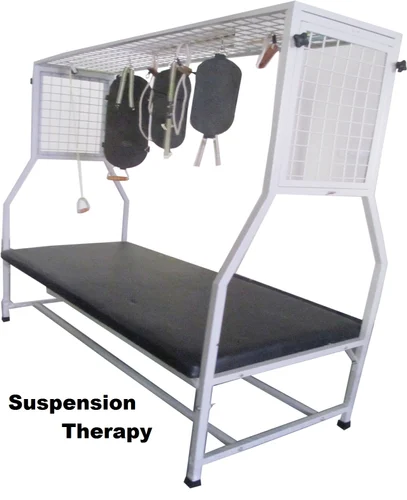What is Suspension Therapy?
Suspension therapy, also known as suspension training, is a versatile and effective form of exercise that utilizes straps, ropes, or similar equipment to leverage body weight for resistance.
A part or the entire body is hung in the air by ropes and slings fastened to a fixed point above during suspension therapy, a type of therapeutic activity. Patients receive this therapy to strengthen their muscles, build muscle power, and use ropes and slings to support various body parts.
Who invented Suspension Therapy?
Guthrie Smith created the device used in suspension therapy.
Types of Suspension Therapy
There are essentially three types of suspension therapy, i.e.
- Axial suspension
- Vertical suspension
- Pendular suspension
Axial Suspension Therapy
- With the employment of the rope, clip, and hook, the axis of suspension is secured slightly above the joint.
- The area of the body being treated moves perpendicular to the floor.
- The point of suspension is considered to be the joint’s axis.
limb that travels in a floor-parallel manner.
Uses of Axial Suspension Therapy
Suspension treatment is used for:
- body portion relaxation
- Preserve the characteristics of the muscle
- a rise in blood flow
- enhances the lymphatic and venous drainage
Vertical Suspension Therapy
- The center of gravity of the body or the affected bodily portion is the point of suspension. The upper one-third or two-thirds is often where the center of gravity is located.
Uses of vertical suspension
- It serves as the body part’s support.
- It is applied to lessen pressure ulcers.
Pendular suspension therapy
With this kind of suspension therapy, the movement is done against gravity and the point of suspension is moved away from the joint axis. Muscles experience resistance when the axis is moved to the opposite side of the action.
Uses of pendular suspension
- It’s employed to lengthen the muscles.
- utilized to boost muscle strength
- It is employed to boost strength and stamina.
Advantages of suspension therapy
- It facilitates raising the limb.
- It lessens the therapist’s workload.
- Less friction allows for the performance of vigorous movements.
Core Stability and Strength:
To stabilize the body during workouts, suspension therapy heavily uses the core muscles. Assisting in the development of core strength and stability is crucial for upholding proper posture, averting injuries, and enhancing general athletic performance.
Functional Movement Patterns:
Suspension therapy is a type of functional training that focuses on doing exercises that resemble everyday movements. Enhancing balance, proprioception, and coordination is beneficial for both everyday living tasks and athletic performance.
Versatility:
Suspension straps are suitable for people of all fitness levels, from novices to expert athletes, because they can be adjusted to change the difficulty of workouts. Suspension straps can also be used for a variety of exercises that target different muscle groups and movement patterns.
Portability and Accessibility:
Suspension straps are useful for usage at home, in the gym, or on trips because they are lightweight and portable.
They take up very little space and are easy to build on a door, tree branch, or other strong anchor point. Because of its accessibility, suspension therapy is a great choice for people who don’t have much access to outdoor or gym environments.
Joint-Friendly:
Exercises in a suspended or partially supported position are frequently performed as part of suspension therapy, which lessens the impact on joints as compared to conventional weight-bearing exercises. This makes it suitable for those with joint pain or mobility issues, allowing them to exercise with less discomfort and risk of injury.
Full-Body Workout:
Suspension training works several muscle groups at once, offering a thorough full-body workout. Because of its efficiency, people can target numerous fitness goals, including strength, endurance, flexibility, and mobility, while also getting the most out of their workouts in terms of both time and energy consumption.
Progressive Overload:
As strength and fitness levels increase, suspension straps allow for progressive overload due to their variable resistance that is dependent on body position and angle. People can continuously push their muscles and adapt to new stimuli by changing their body posture or increasing their instability, which will result in continuous gains in strength and performance.
Enhanced Proprioception and Neuromuscular Control:
Increased proprioceptive awareness and neuromuscular control are necessary for suspension therapy to preserve stability and regulate movement. This can enhance motor abilities, coordination, and general movement efficiency over time, leading to enhanced sports performance and a lower chance of injury.
Disadvantages of Suspension Therapy
- Using this therapy can be a little challenging.
- Equipment is highly expensive.
- Therapy must be used in a large room or area.
- For this therapy, a variety of equipment is needed.
Initial Learning Curve:
For activities in suspension training to be done safely and successfully, the right technique and body awareness are needed. There could be a learning curve for beginners as they get used to adjusting the straps, staying stable, and managing their body position while performing exercises. Inadequate advice or instruction increases the likelihood of doing exercises improperly, which increases the risk of injury.
Risk of Overexertion:
Suspension training can be difficult, particularly for people who are not very strong or stable or who are new to exercising. Excessive exertion, muscle strain, and joint injury are risks associated with pushing too hard or completing advanced workouts before understanding basic techniques. To prevent going overboard, it’s critical to advance cautiously and pay attention to your body’s cues.
Potential for Imbalance:
Even though suspension treatment works for several muscle groups at once, some exercises could focus more on one side of the body than the other. If exercises are not balanced between left and right sides or opposing muscle groups, this may result in muscular imbalances. By including unilateral workouts and emphasizing symmetry, this danger can be reduced.
Requirement for Anchoring Point:
A sturdy anchor point, such as a door, beam, tree branch, or ceiling mount, is usually needed for suspension training to fasten the suspension straps. Suspension therapy may not always be accessible due to difficulties or unavailability in locating a suitable anchor point. Furthermore, inadequate support or incorrect anchoring may jeopardize exercise safety.
Limited Resistance Progression:
Suspension straps provide resistance that may be adjusted according to body position and angle but for those looking to make big strength improvements, body weight resistance may eventually become too much. It could be difficult to keep getting stronger over time without additional external resistance or progression techniques, like weighted vests or advanced exercises.
Potential for Overuse Injuries:
A large number of bodyweight exercises are part of suspension training, which may raise the risk of overuse injuries, especially if done incorrectly or excessively. If balanced with proper rest and recuperation, repetitive motions like tugging or pushing against the straps might damage muscles, tendons, or joints.
Cost and Equipment Accessibility:
Suspension straps still need an initial investment, even if they are more reasonably priced than certain gym equipment. Suspension strap purchases can be too expensive for anyone on a limited budget or who would rather have the bare minimum of gear. Suspension therapy may not be feasible for certain people due to environmental factors that affect access to appropriate anchoring points.
Not Suitable for Everyone:
People with particular illnesses, injuries, or physical restrictions might not be good candidates for suspension training. Before beginning a suspension therapy program, anyone with significant balance problems, unstable joints, or prior musculoskeletal injuries should speak with a healthcare provider to make sure everything is safe and acceptable.
What Constitutes a Suspension Therapy Part?
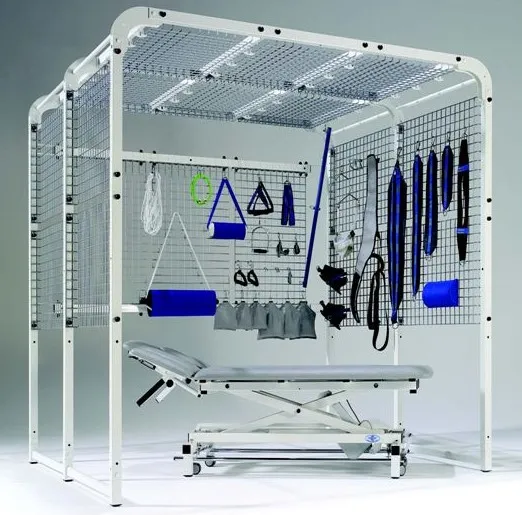
Suspension treatment components
1. Fixed point: the suspension system
2. pulley
3. Supporting ropes
- Just one rope
- Two ropes
- A pulley rope
4. Sling
- One sling only
- Two-sling
- sling with three rings
- sling in the head
5. Wooden cleat:
6.S hook, dog clip
Frame for suspension:
- It is made of steel that has been coated in plastic or stainless steel.
- The 5cm metal mesh is visible on the head-end side and ceiling, while the other sides are kept open.
Pulley:
It offers a benefit in terms of mechanics. To reduce the strain of raising the complete body or specific body parts, pulleys are used. Depending on the situation, single or double pulleys may occasionally be used. if the body part is too large. For instance, two pulleys are used in the thigh, thorax, and trunk.
Supporting rope:
To prevent dropping, three different types of supporting ropes are used for suspension.
- Just one rope
- A pulley rope
- Two rope
Just one rope
- It is hinged up at one end by a circle that has been settled.
- The other end of the rope is knotted after passing through the circle of a dog clip on one end of the wooden cleat and the other end of the cleat.
A pulley rope
- This features a dog clip attached to one end of the rope, which crosses a pulley’s spin.
- After that, the rope goes through the second dog clip and cleats.
Two ropes
- consists of more inferior connectors and two pulleys at the higher.
- Thus, there is a two-fold computerized benefit here.
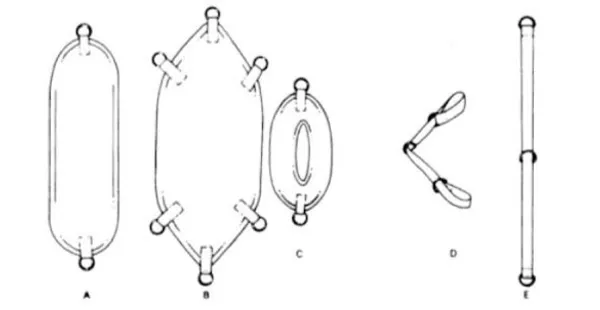
Slings
Four categories of functional slings exist:
- Just one sling
- Two-sling
- sling with three rings
- sling in the head
Just one sling
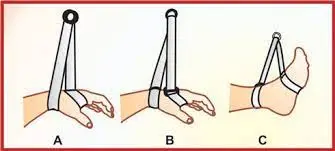
- Slings made of canvas that has been covered with silky webbing and has a D-ring on both ends.
- Dimensions: Length 68 cm, Width 17 cm.
- functioned for knee and elbow joint motion
- The figure of eight is sometimes tucked in to support the ankle and wrist.
Two-sling
- Greater than one sling
- With the D-circle rings, it will have more than two sides.
- functioned to support greater areas, such as the thigh, trunk, and thorax.
- Dimensions: Length 68 cm, Width 29 cm.
Sling with three rings
- Dimensions: 75cm in length and 3–4cm in width, with 3-D circular rings included.
- The preserved force was maintained by two D-circle rings at the sling’s ends and one in the middle.
- Operated in the regions of the wrist and ankle.
Head sling
- This is a short, divided sling that has a midway slit created by sewing its two pieces together at an arc.
- It is designed to support the head in the middle of the sling and has a slit to accommodate the lower ear when side-lying and the occipital region when supine.
Wooden cleat
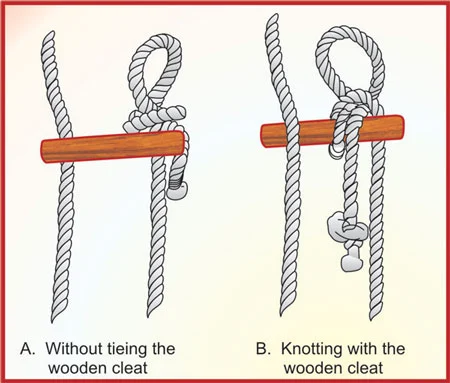
- It is made of wood and is used to change the length of the rope.
- For the rope passage, there are two or three gaps.
- The cleat is carried by friction resistance in the rope itself.
S hook or dog clip
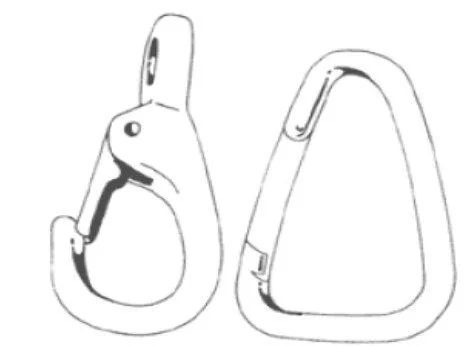
- made of wood
- A canine clip is used to join the suspension frame and the supporting rope.
- Use a supporting rope to secure the sling.
Principles of Suspension Therapy
Friction
When one surface slides across another, it occurs. It is possible to move easily and smoothly in suspension.
Pendulum
When force is applied to the pendulum, it moves to and fro. The hip and shoulder joints in humans can move pendulously.
Elimination of gravity movement
Individuals with a power grade of two may be eligible for suspension therapy. If the patient’s muscle power is less than 2, it will be challenging for them to complete the therapeutic exercise. For suspension therapy exercises, the patient’s muscle contraction power should be modest. If the patient’s muscle power exceeds three, they can engage in gravity exercise.
The Technique of Suspension Therapy
Shoulder Abduction and Adduction:
Muscles name:
Abductor:
- 0-15 degrees: Supraspinatus
- 15-90 degrees: Medial Deltoid
- 90-180 degrees: Trapezius and serratus anterior.
Adductor:
- Pectoralis major
- Latissimus dorsi
- Teres major.
Position of the patient: Supine lying position.
Point of suspension: Approximately one inch behind the scapula’s acromion process.
Accessories required:
- S-hooks: 3
- Three-ring sling: 1
- Single sling: 1
- Supporting rope with wooden clit: 2
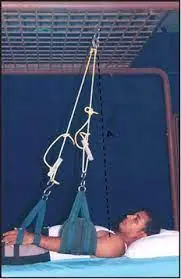
Procedure:
- The primary supporting rope, which is fastened to the suspension frame by an s-hook, assumes the suspension point to be one inch below the scapula’s acromion process.
- The identical s-hook is used to connect a second supporting rope.
- The wrist is supported by an operable three-ring sling.
- The elbow is reinforced with a single sling.
- The wrist sling is attached to the main supporting rope.
- An additional rope for stability is attached to the elbow sling.
- It is advised that the patient perform shoulder adduction and abduction exercises.
- The axis is removed to intensify the medial motion of the abductor and vice versa for adductor intensification.
Shoulder Flexion and Extension
Muscles name:
- Flexor- Anterior deltoid, pectoralis major, and coracobrachialis.
- Extensor-Extensor muscles include the posterior deltoid, teres major and minor, and latissimus dorsi.
Position of patient– Side-lying.
Point of suspension: Greater tuberosity
Accessories required:
- S-hooks: 3
2. Three-ring sling: 1
3. Single sling: 1
4. Supporting rope with wooden cleat: 2
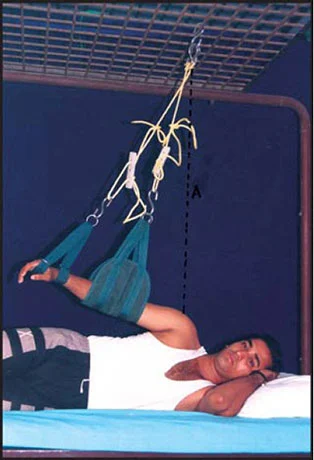
Procedure
- By attaching the supporting rope, greater tuberosity is presumed to be the suspension point. This is attached to the suspension frame by an s-hook.
- The same s-hook is used to secure a second supporting rope.
- A three-ring sling is used to provide wrist support.
- The elbow is supported with a single sling.
- The wrist sling is attached to the main supporting rope.
- The elbow sling is attached to a second supporting rope.
- It is advised that the patient perform shoulder flexion and extension exercises.
- The axis is accepted out for extensor strengthening and vice versa for flexor posterior motion reinforcement.
Shoulder Medial and Lateral Rotation
Muscles name:
- Medial Rotation: The medial rotator is the latissmus dorsi, teres major, anterior Deltoid, and subscapularis occurs.
- Lateral Rotation: Posterior Deltoid, Infraspinatus, Teres minor
Position of the patient: Supine lying.
Point of suspension: Olecranon process.
Accessories required:
1. S-hook: 4
2. Three-ring sling: 1
3. Single sling: 1
4. Supporting rope with wooden cleat: 2
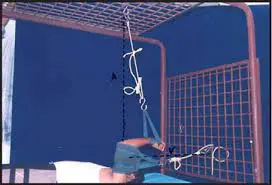
Procedure:
- A primary supporting rope that is fastened by an s-hook to the suspension frame assumes the olecranon process as the suspension point when the shoulder and elbow are bent 90 degrees and flexed 90 degrees, respectively.
- Another s-hook in the vertical suspension connects the secondary rope to the head-side suspension frame.
- An operating three-ring sling is used to strengthen the wrist.
- The arm is maintained with just one sling.
- The wrist sling is attached to the main supporting rope.
- The arm sling is attached to a second supporting rope.
- The patient is instructed to rotate their shoulder both medially and laterally.
- Lateral shifting of the axis is drawn out to strengthen the medial rotator and vice versa for the lateral rotator.
Elbow Flexor and Extensor
Muscle name:
- Flexor: Biceps brachii, Brachioradialis, and Brachialis.
- Extensor: Anconeus and Triceps brachii.
Position of the patient: Sitting.
The lateral epicondyle of the humerus bone is the point of suspension.
Accessories required:
- S-hooks: 4
2. Three-ring sling: 1
3. Single sling: 1
4. Supporting rope with wooden cleat: 2
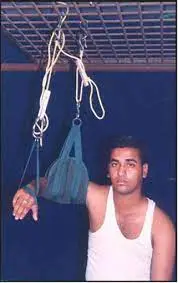
Procedure:
- The primary supporting rope, which is fastened by the s-hook with the suspension frame, assumes the lateral epicondyle as the suspension point when the shoulder is abducted at a 90-degree angle and the elbow is flexed to a 90-degree angle.
- Another s-hook in vertical suspension connects the secondary supporting rope to the suspension frame.
- The wrist is strengthened with a three-ring sling.
- The arm is maintained with just one sling.
- The wrist sling is attached to the main supporting rope.
- The arm sling is attached to a second supporting rope.
- The elbow flexion and extension action is performed by the patient under guidance.
- The axis is dragged out laterally to strengthen the flexors and in the opposite direction for the extensors.
Hip Flexion and Extension
Muscle name:
- Hip flexion: Tensor fascia lata, Pectineus, Sartorius, Iliopsoas, and Rectus femoris are the muscles that flex.
- Hip Extension: Gluteus maximus, Biceps femoris.
Position of the patient: Side-lying.
Point of suspension: Femur’s greater trochanter.
Accessories required:
1. S-hooks: 3
2. Three-ring sling: 1
3. Single sling: 1
4. Supporting rope with wooden cleat: 2
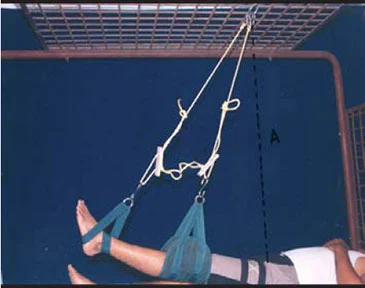
Procedure:
- A primary supporting rope that is fastened to the suspension frame by an s-hook assumes the greater trochanter as the suspension point.
- The identical s-hook is used to connect a second supporting rope.
- The knee is supported by a single sling.
- The ankle is supported using a three-ring sling.
- The ankle sling is attached to the main supporting rope.
- The knee sling is attached to a second supporting rope.
- The hip flexion and extension movements are performed by the patient under guidance.
- The axis is shifted posteriorly to increase the strength of the flexor and vice versa for the extensors.
Hip Abductor and Adductor
Muscles name:
- Abductor: Gluteus medius and Gluteus minimus
- Adductor:The longus, magnus, and brevis adductor muscles are the adductor.
The patient is laying in a supine position with their hips fully abducted.
Two inches below the anterior superior iliac spine (ASIS) is the point of suspension.
Accessories required:
- S-hooks: 3
2. Three-ring sling: 1
3. Single sling: 1
4. Supporting rope with wooden cleat: 2
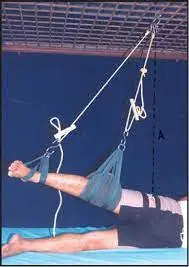
Procedure:
- The primary supporting rope, which is fastened by the s-hook with the suspension frame, accepts two inches below the anterior superior iliac spine (ASIS) as the suspension point.
- The identical s-hook is used to connect a second supporting rope.
- An ankle and foot sling with three rings is used for reinforcement.
- The knee is supported by a single sling.
- The ankle sling is attached to the main supporting rope.
- The knee sling is attached to the secondary supporting rope.
- The hip abduction and adduction movements are guided by the patient.
- Medial shifting of the axis is drawn out to strengthen the abductor and vice versa for adductor strengthening.
Hip Medial and Lateral Rotation
Muscle name:
- Medial Rotator: The medial rotators are the gluteus minimus and the tensor fascia lata.
- Lateral Rotator: Piriformis, Gluteus maximus, Obturator externus, Obturator enternus, Obturator inferiorus, and Superior gemellus.
Position of the patient: Supine lying.
The apex of the patella bone is the point of suspension.
Accessories required:
- S-hooks: 4
2. Three-ring sling: 1
3. Single sling: 1
4. Supporting rope with wooden cleat: 2
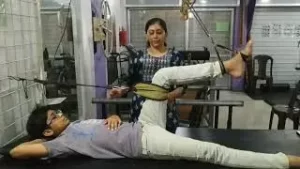
Procedure:
- The primary supporting rope, which is fastened by the s-hook with the suspension frame, accepts the patella’s apex as the suspension point.
- Another s-hook joins the secondary supporting rope to the head side suspension frame.
- The ankle is kept in place by a three-ring sling.
- The thigh is kept in place using a single sling.
- The ankle sling is attached to the main supporting rope.
- The thigh sling is attached to a supplementary supporting rope.
- The hip’s medial and lateral movements are guided by the patient.
- The axis is dragged outward to enhance the strengthening of the medial rotator and in the opposite direction for the lateral rotator
Knee Flexion and Extension
Position of the patient: Side-lying.
Point of suspension: The knee joint’s lateral joint line.
Accessories required:
- S-hooks: 4
2. Three-ring sling: 1
3. Single sling: 1
4. Supporting rope with wooden cleat: 2
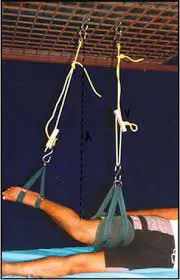
Procedure:
- The primary supporting rope, which is fastened to the suspension frame by an s-hook, accepts the lateral joint line as the suspension point.
- The secondary supporting rope assumes that the thigh’s COG is the suspension point. This is attached in a vertical suspension by another s-hook to the head side suspension.
- Ankle reinforcement is provided with a three-ring sling.
- The thigh is supported with a single sling.
- The ankle sling is attached to the main supporting rope.
- The thigh sling is attached to a supplementary supporting rope.
- The patient is assisted in executing the knee’s flexion and extension movements.
For Whole Body Suspension
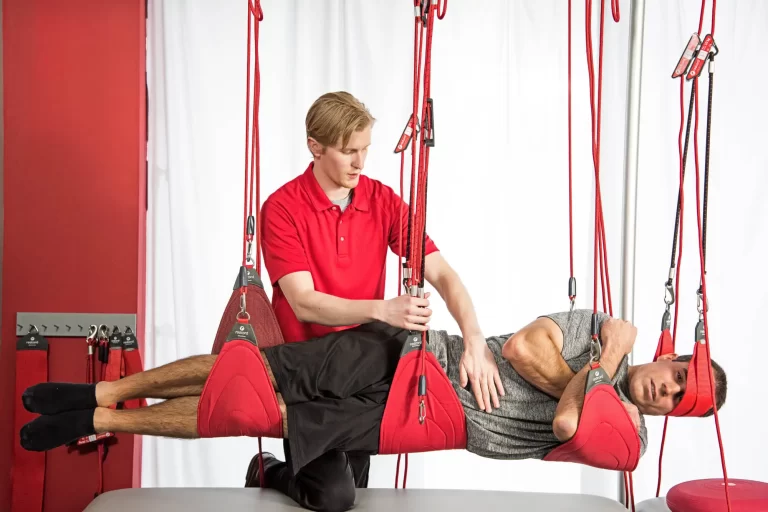
Each limb is suspended vertically by independent slings using strengthening ropes. To set the full-body suspension, the head, upper and lower trunks, and both upper and lower extremities are balanced with independent supporting ropes in the vertical suspension.
Conclusion
In conclusion, suspension therapy, or suspension training, is a highly effective form of exercise that utilizes suspended straps or ropes anchored to a fixed point to engage multiple muscle groups simultaneously.
Treatment using suspension therapy appears to be promising for increasing muscle strength, balance, and range of motion. Research has demonstrated that children with cerebral palsy can benefit from suspension therapy.
FAQ
What are the disadvantages of suspension therapy?
One Drawback of Suspension Treatment
Particularly intricate and not necessarily the first choice for novices in resistance training.
it required numerous items, such as pulleys, ropes, and slings.
What is the use of a suspension bed?
Patients with serious burns recover more quickly and comfortably while using suspension beds, which also reduce infection and speed up the healing of scabs on the entire body. Patients with significant burns respond particularly well to clinical therapy in a suspended bed.
Is suspension therapy active or passive?
The patient is encouraged to participate actively in suspension therapy. To raise the muscle grade, it is primarily applied to the second-graded muscles. It encourages relaxation by using supportive, rhythmic, and fluid movements.
What are the benefits of using suspension therapy?
What advantages does suspended therapy offer?
Because suspension training equipment uses the pendulum effect—a technique that uses gravity and the user’s body weight against body angle, body stability, and body momentum—it can help prevent and treat injuries by promoting the simultaneous development of strength, balance, flexibility, and core stability during a variety of exercises.
How many slings are used in suspension therapy?
For the suspension treatment of the hip joint
The foot and ankle are supported using a three-ring sling. The knee is supported with one sling. The ankle sling is fastened to the main supporting rope. The knee sling is linked to the secondary supporting rope.
What is a type of suspension therapy?
A unique form of exercise therapy known as suspension therapy involves suspending a body component using a rope, sling, or pulley system. Body parts can be suspended in a variety of ways depending on the demands of exercise. This video discusses several methods of suspending body parts along with their benefits and drawbacks.
What is the oldest type of suspension?
The earliest type of suspension, which dates back to horse-drawn carriages in the Middle Ages, is the leaf spring. Up until the 1970s, European cars were typically equipped with leaf spring suspension; however, more advanced suspension systems were then employed for improved handling and ride quality.
What is friction in suspension therapy?
Interaction. it happens when one surface moves across another. Because there is less friction in suspension, it is easy and smooth. motion.
Who invented suspension therapy?
Background: A. Motschutkovsky, a Russian physician, invented suspension therapy, which gained popularity as a tabes dorsalis treatment towards the end of the 1800s.
What is the history of suspension therapy?
After being presented by Motschutkovsky in 1883 and made popular by Charcot and Gilles de la Tourette in 1889, the suspension therapy of tabes dorsalis spread quickly and extensively thanks to positive case reports.
Reference:
- Vaghela, D. (2023, December 13). Suspension Therapy – Principles, Types, Parts, Indications – Mobile. Mobile Physiotherapy Clinic. https://mobilephysiotherapyclinic.in/suspension-therapy/
- Daddy, P. (2023, November 8). What is suspension therapy – types, uses types of equipment? Physio Daddy. https://physiodaddy.com/what-is-suspension-therapy-types-uses-equipments/

